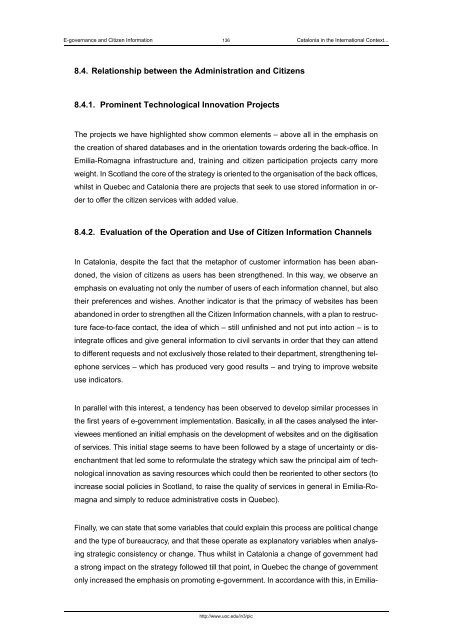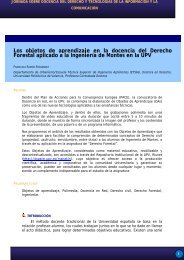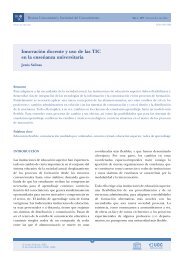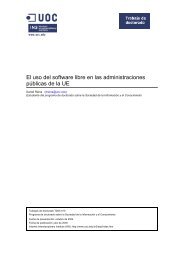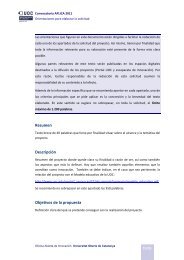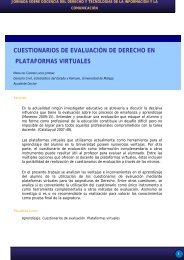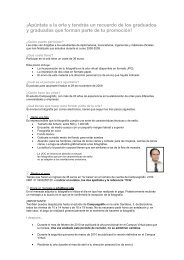e-governance and citizen information - Universitat Oberta de ...
e-governance and citizen information - Universitat Oberta de ...
e-governance and citizen information - Universitat Oberta de ...
You also want an ePaper? Increase the reach of your titles
YUMPU automatically turns print PDFs into web optimized ePapers that Google loves.
E-<strong>governance</strong> <strong>and</strong> Citizen Information 136 Catalonia in the International Context...8.4. Relationship between the Administration <strong>and</strong> Citizens8.4.1. Prominent Technological Innovation ProjectsThe projects we have highlighted show common elements – above all in the emphasis onthe creation of shared databases <strong>and</strong> in the orientation towards or<strong>de</strong>ring the back-office. InEmilia-Romagna infrastructure <strong>and</strong>, training <strong>and</strong> <strong>citizen</strong> participation projects carry moreweight. In Scotl<strong>and</strong> the core of the strategy is oriented to the organisation of the back offices,whilst in Quebec <strong>and</strong> Catalonia there are projects that seek to use stored <strong>information</strong> in or<strong>de</strong>rto offer the <strong>citizen</strong> services with ad<strong>de</strong>d value.8.4.2. Evaluation of the Operation <strong>and</strong> Use of Citizen Information ChannelsIn Catalonia, <strong>de</strong>spite the fact that the metaphor of customer <strong>information</strong> has been ab<strong>and</strong>oned,the vision of <strong>citizen</strong>s as users has been strengthened. In this way, we observe anemphasis on evaluating not only the number of users of each <strong>information</strong> channel, but alsotheir preferences <strong>and</strong> wishes. Another indicator is that the primacy of websites has beenab<strong>and</strong>oned in or<strong>de</strong>r to strengthen all the Citizen Information channels, with a plan to restructureface-to-face contact, the i<strong>de</strong>a of which – still unfinished <strong>and</strong> not put into action – is tointegrate offices <strong>and</strong> give general <strong>information</strong> to civil servants in or<strong>de</strong>r that they can attendto different requests <strong>and</strong> not exclusively those related to their <strong>de</strong>partment, strengthening telephoneservices – which has produced very good results – <strong>and</strong> trying to improve websiteuse indicators.In parallel with this interest, a ten<strong>de</strong>ncy has been observed to <strong>de</strong>velop similar processes inthe first years of e-government implementation. Basically, in all the cases analysed the intervieweesmentioned an initial emphasis on the <strong>de</strong>velopment of websites <strong>and</strong> on the digitisationof services. This initial stage seems to have been followed by a stage of uncertainty or disenchantmentthat led some to reformulate the strategy which saw the principal aim of technologicalinnovation as saving resources which could then be reoriented to other sectors (toincrease social policies in Scotl<strong>and</strong>, to raise the quality of services in general in Emilia-Romagna<strong>and</strong> simply to reduce administrative costs in Quebec).Finally, we can state that some variables that could explain this process are political change<strong>and</strong> the type of bureaucracy, <strong>and</strong> that these operate as explanatory variables when analysingstrategic consistency or change. Thus whilst in Catalonia a change of government hada strong impact on the strategy followed till that point, in Quebec the change of governmentonly increased the emphasis on promoting e-government. In accordance with this, in Emilia-http://www.uoc.edu/in3/pic


